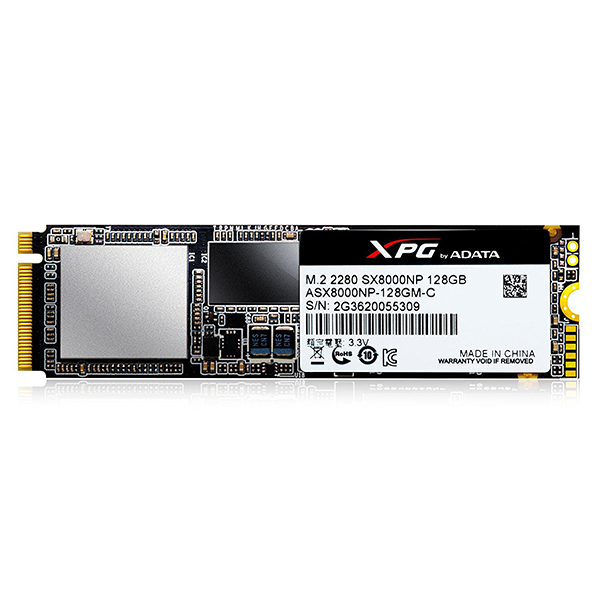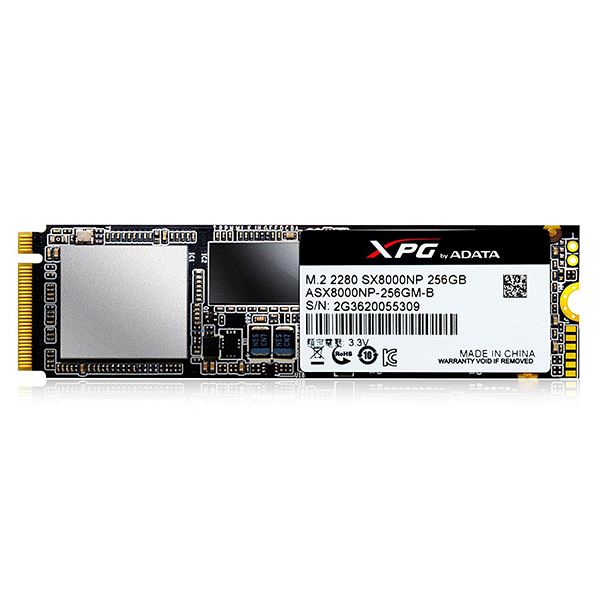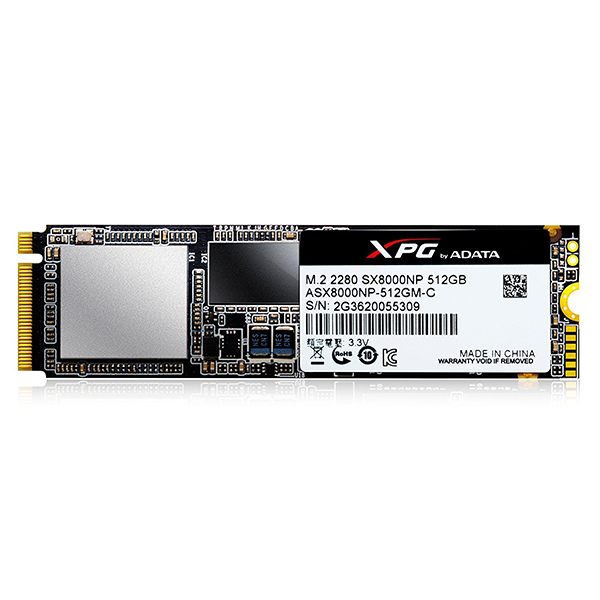Early Verdict
The Adata XPG SX8000 outperforms the Intel 600p, but it sells at the same price as the Samsung 960 EVO. The drive doesn't do much to overcome the MyDigitalSSD BPX that currently leads the low-cost NVMe market. The SX8000 features advanced cache technology but it's more of a Band-aid to correct issues with the Micron MLC.
Pros
- +
Advanced cache technologies
- +
Better performance than the Intel 600p
- +
Better endurance than the 600p
Cons
- -
Mainstream pricing
- -
Entry-level performance
- -
Low MLC performance
- -
Low endurance
Why you can trust Tom's Hardware
Features & Specifications
The NVMe secret is out, and every company with a little influence is in the game. Reaching the highest performance tier is difficult without a Samsung-sized engineering team, but controller designers are closing the gap with in-house firmware that offers second-tier manufacturers a fighting chance in the entry-level and mainstream markets.
Adata is one of the few companies that still works with every third-party SSD controller manufacturer. The company uses that insight to cross-pollinate features that increase performance, endurance, and just about every other notable attribute. The new Adata XPG SX8000 uses the Silicon Motion, Inc. (SMI) SM2260 controller (the same found in the Intel 600p) in tandem with a large DRAM package that works as both a data buffer and cache for the flash translation layer. The drive also uses Micron's 3D MLC NAND, so it should improve the lazy, and often inconsistent, write performance we found with the Intel 600p.
To help reduce manufacturing costs, Adata often purchases NAND by the wafer from Micron. Few companies purchase enough volume to buy directly from the NAND fab. Even fewer have the technology and knowledge to sort and bin the parts properly. The Adata XPG SX8000 is the first part we've tested with Micron NAND packaged by a third-party. This is excellent news for end users because it means Micron finally has enough production to sell at the wafer level. It also means the yields are high enough for companies like Adata to buy wafers without experiencing massive losses due to the amount of poor quality die. If a company knows a significant percentage of the parts will be bad, they wouldn't buy the wafer and expel resources to test the parts. It appears that we've reached a tipping point where in-house NAND testing is more favorable than buying known good components.
We haven't been kind to IMFT (Intel Micron Flash Technology) 3D flash since its release in consumer products. The technology is impressive on paper, but in practice, we've found high latency that hurts performance. The TLC's 384Gbit die promised to bring us ultra-high capacity products in 2017, but that hasn't materialized because SSD manufacturers need the extra space for massive SLC-programmed buffers just to equalize performance. Vendors have delegated one-third of the density to single-level cell operation in a gambit to increase performance. IMFT's new 256Gbit 3D MLC took longer to materialize in retail products but it, too, has been a disappointment thus far.
Specifications
The XPG SX8000 comes to market in four capacities that range from 128GB to 1TB. The 1TB model is not available at the time of writing. The flash shortage has placed a heavy strain on the supply of high die count NAND packages. Adata isn't the only company with an announced, but missing, 1TB model.
The XPG series is Adata's prosumer/high-end desktop product line, so we expect excellent performance with the SX8000. High performance is relative in a world where Samsung has such a large technology lead compared to the rest of the market. On paper, the series provides up to 1,900/1,100 MB/s of sequential read/write throughput. Random performance reaches as high as 160,000 read IOPS, but only on the large 1TB model. The 512GB drive drops to 140,000 and the smaller drives achieve just 45,000 (128GB) and 85,000 IOPS (256 GB). The SX8000 512GB has the highest random write performance in the series at 150,000 IOPS. The 1TB and 256GB both share the same 140,000 random write IOPS specification, but that drops to 100,000 IOPS for the 128GB.
The SX8000 is one of the first consumer SSDs to utilize Micron's 3D MLC flash. Micron announced the MLC NAND with CMOS under the array technology quite a long time ago, but the SX8000 is the first mainstream SSD with wide availability. We first saw the flash on the Tigo G5, but that's more of a regional release rather than a global launch.
Get Tom's Hardware's best news and in-depth reviews, straight to your inbox.
Pricing And Accessories
As mentioned, the SX8000 1TB is currently missing in action, but there are three products available. The SX8000 128GB currently sells for $89.99, the 256GB sells for $129.99 and the 512GB for $249.99. The prices are a little higher than quoted during the announcement a few months back, but NAND supply has tightened in the interim.
The XPG SX8000 doesn't ship with any accessories in the retail package, but the drive works with the company's SSD Toolbox software as well as a custom version of Acronis True Image HD. You can download both utilities from Adata's website.
Warranty And Endurance
The XPG SX8000 products ship with a limited five-year warranty and a higher endurance rating than the Intel 600p. The SX8000 512GB we are testing delivers 320 TB of endurance, as opposed to just 288TB for the Intel 600p. The SX8000 offers similar endurance gains over the Intel 600p at each capacity point.
Product Packaging

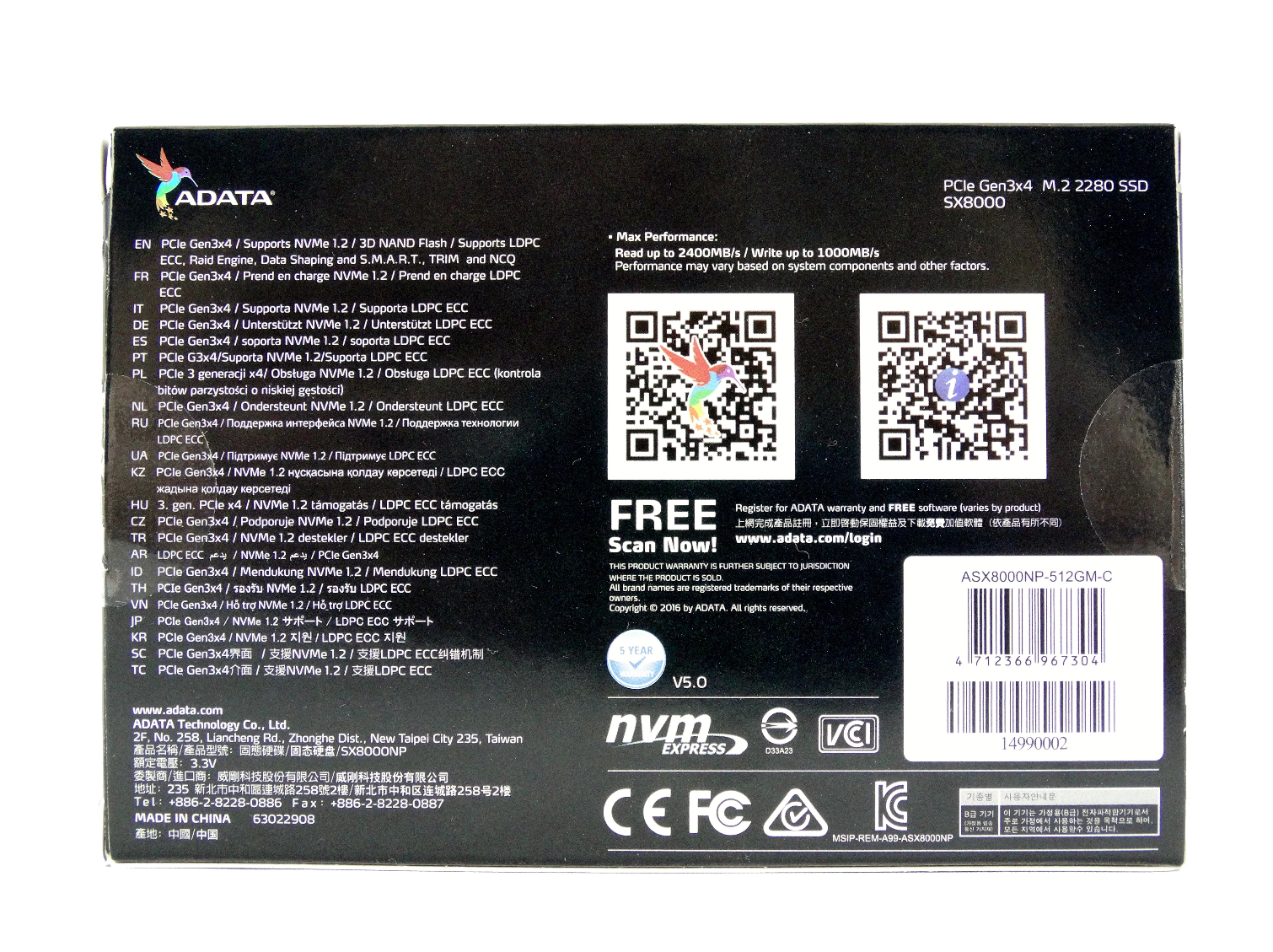

The Adata XPG SX8000 uses the chrome motif that debuted with the Ultimate SU800. The theme seems to follow Adata's 3D flash enabled products. It was also a visible feature on the SD700 External SSD package.
The company listed some of the features, but the package lacks many of the useful specifications we use to compare products in a retail brick and mortar environment.
A Closer Look

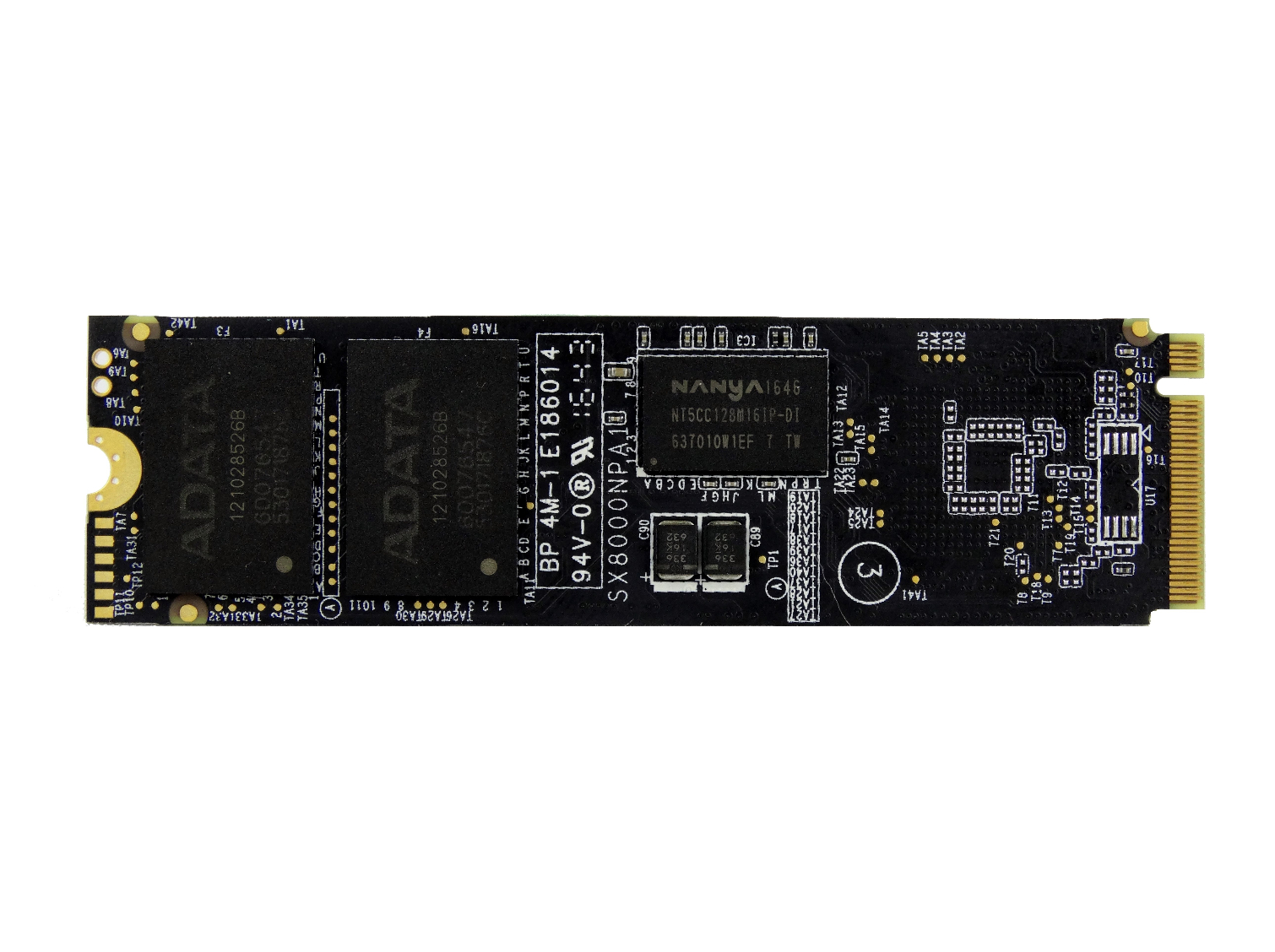


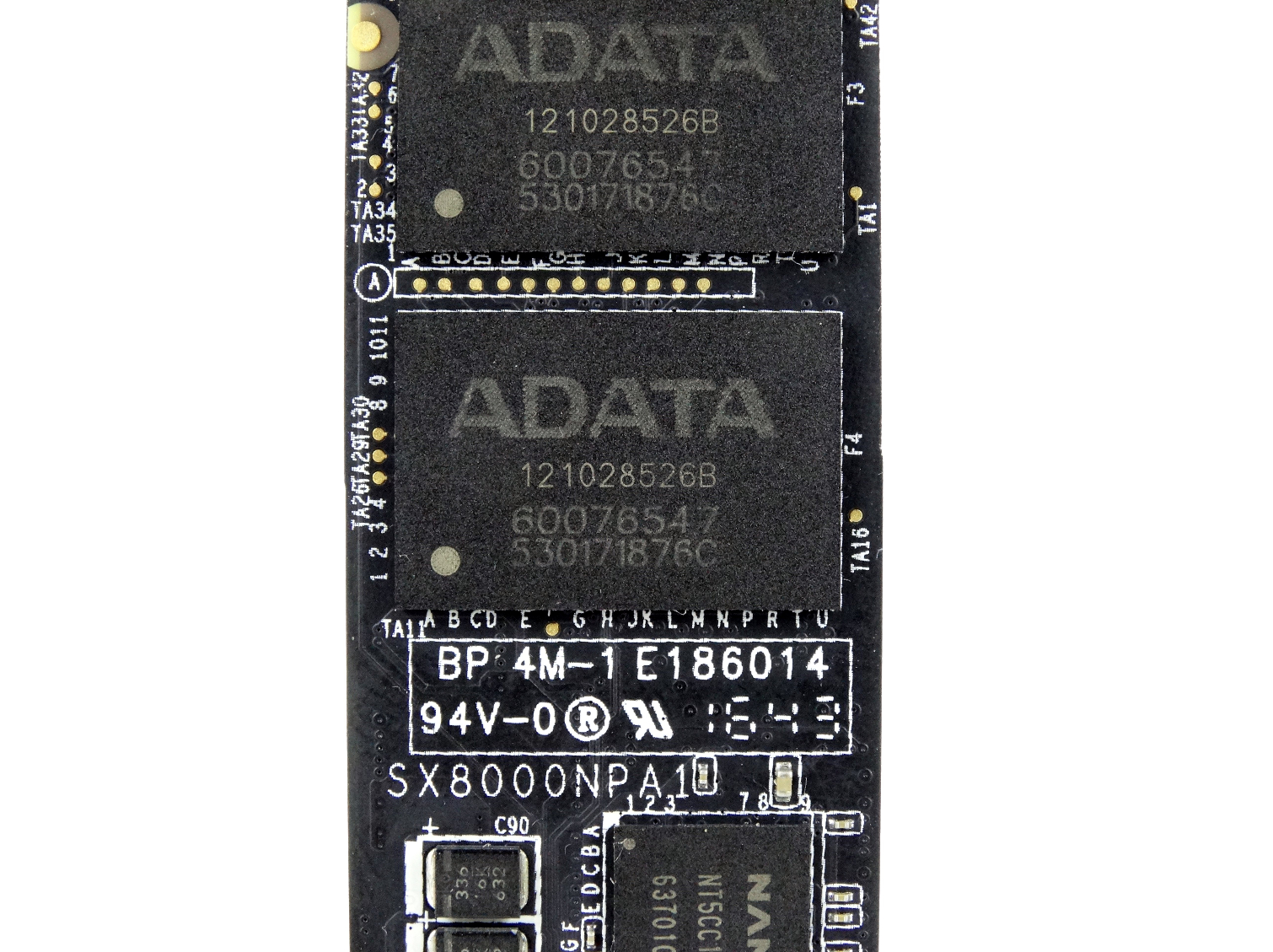
Several of the tier-one SSD manufacturers went to extremes to build single-sided M.2 SSDs, but only a few notebooks require the thin design. It's cheaper to build M.2 2280 SSDs with components on both sides, so that's the design Adata used for the SX8000.
The SMI SM2260 is easily recognizable since it's the only controller shipping with a thin copper cover to wick heat away from the center of the controller. We peeled it off of our Intel 600p after testing, but didn't find any laser-etched text under the copper.
The SX8000 512GB uses two 256MB DRAM packages, one on each side, for a total of 512MB. We're not sure if Adata uses one for the data path buffer and the other for the flash translation layer map data. Adata placed a pair of solid-state capacitors next to each DRAM package. The capacitors provide enough power to flush the data from the DRAM to the NAND in the event of a host power failure.
The big story here is that Adata packaged Micron 256Gbit MLC NAND. This could have widespread meaning, or it could just be that Adata picked up the wafers at a deep discount. I like to think positively, so I'm more inclined to think with a year of meaningful manufacturing IMFT was able to increase 3D yields rather than dumping low-yield wafers to third parties.
MORE: Best SSDs
MORE: How We Test HDDs And SSDs
MORE: All SSD Content

Chris Ramseyer was a senior contributing editor for Tom's Hardware. He tested and reviewed consumer storage.
-
geoffw_1 Thanks for all the behind-the-scenes development issues and insights. Why no mention of the TLC competition emerging though?Reply -
logainofhades NVME may be faster, but with their horrible price/GB ratio, there is no way I would consider one for myself.Reply -
bit_user Reply
At least it (mostly) out-performs Intel's lousy 600p. That should be the minimum standard for all NVMe SSDs.19702804 said:So it costs the same as a 960 EVO but performs a lot worse. THANKS A BUNCH, ADATA!!
-
HERETIC-1 Hi Chris,Reply
Can be a crummy job at times-struggling to find something nice/positive to say.
Adata should be getting them wafers at a reasonable price-No one else wants it.
Do you know what nm IMFT are using here?????????????
Sure I read somewhere 20nm.
Know Sammy went back to 30/40nm.
Could that be part of the problem?? Trying to be too greedy??? -
gdmaclew Why are your links showing Corsair Vengeance 8GB DDR3 Ram as $269.99 at Amazon when Amazon has it listed (if you click on the link) as $54.99?Reply

